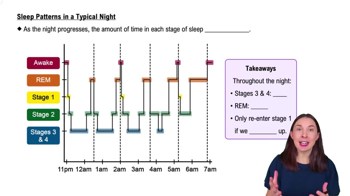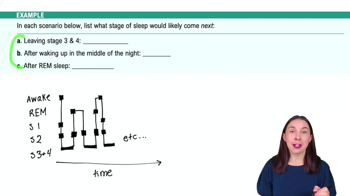Table of contents
- 1. Introduction to Psychology1h 43m
- 2. Psychology Research2h 20m
- 3. Biological Psychology2h 41m
- 4. Sensation and Perception28m
- 5. Consciousness and Sleep32m
- 6. Learning41m
- 7. Memory34m
- 8. Cognition37m
- 9. Emotion and Motivation35m
- 10. Developmental Psychology33m
- 11. Personality48m
- 12. Social Psychology41m
- 13. Stress and Health41m
- 14. Psychological Disorders44m
- 15. Treatment47m
5. Consciousness and Sleep
Sleep
Struggling with Psychology?
Join thousands of students who trust us to help them ace their exams!Watch the first videoMultiple Choice
With respect to a babies' needs, caregivers of _____ babies are unresponsive, insensitive, and coldly rejecting.
A
secure
B
avoidant
C
ambivalent
D
disorganized-disoriented
 Verified step by step guidance
Verified step by step guidance1
Understand the context of attachment theory, which was developed by John Bowlby and Mary Ainsworth, to explain the dynamics of long-term relationships between humans, especially as it relates to how infants form attachments with their caregivers.
Recognize the different types of attachment styles identified in attachment theory: secure, avoidant, ambivalent (also known as anxious-resistant), and disorganized-disoriented.
Identify the characteristics of each attachment style: Secure attachment involves caregivers who are responsive and sensitive to the baby's needs. Avoidant attachment involves caregivers who are unresponsive, insensitive, and coldly rejecting. Ambivalent attachment involves caregivers who are inconsistent in their responsiveness. Disorganized-disoriented attachment involves caregivers who are erratic and frightening.
Focus on the description given in the problem: 'unresponsive, insensitive, and coldly rejecting.' Match these characteristics to the appropriate attachment style.
Conclude that the attachment style described in the problem is 'avoidant,' as it aligns with the characteristics of caregivers who are unresponsive, insensitive, and coldly rejecting.

 3:25m
3:25mWatch next
Master Circadian Rhythms with a bite sized video explanation from Hannah Gordils
Start learningRelated Videos
Related Practice


































































































![Race, Genes and IQ Differences | Bret Weinstein [Mini Clip]](https://img.youtube.com/vi/IztL_m3pd70/mqdefault.jpg)



































































































